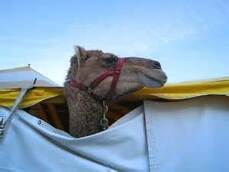 Is it time to sharpen your skills of discrimination when you opened a tent flap for the Camel to nuzzle its nose in? Slowly, but not gracefully, the Camel is now…Ta Dah…finally and fully…in the tent. Out on the desert, a camel is a wondrous creature. It is graceful as it glides upon the arid dunes of time. It travels without food, water and shade for days. Few animals have its strength, stamina and endurance. But now, in the foreign environment of the tent, it tramples upon, and continues to destroy whatever appears as an obstruction in its path. It loved the power of accomplishing its goal of getting into the tent. But once in, it has now transformed into a clumsy and graceless creature, severely confused and in turn, increasingly more destructive. The camel flounders about its newly conquered space sipping ambrosia from golden goblets and nibbling fast food left on silver trays. It crashes into whatever objects or people that appear in its path as it pompously dances and prances in incoherent circles thrusting its hind quarters to and fro, like a Parisian Can-Can dancer. Some have run for cover while others gleefully follow behind, hypnotically beating drums and shaking tambourines of encouragement. Where is the discrimination? The camel has no respect for the opulent oval tent space it now occupies. It defies and defiles all those trying to direct or redirect it and oust it from a place where it does not belong. Before the camel appeared, the tent had been a gathering place for chiefs of many tribes, and clergy of varying spiritual beliefs. It was a place for generals of many countries and peacemakers from throughout the lands to meet. Philosophers and theologians, with or without a pulpit, could gather together without rancor, to honor their differences as well as similarities. As the camel suddenly appeared some did nothing to stop it, and in the paralysis of their silence they acquiesced to its unruly behavior. They passively watched as the check and balance system to maintain order was flagrantly violated. At first, the appearance of the Camel’s nose with its wide bridge and flaring nostrils seemed benign and even humorous. But now that it has inched its entire body into a space where it does not belong, it has become a frightening symbol of division and separation. It has no respect for any order of what existed before, nor does it care. In losing its way and purpose, the camel now bares its teeth and spits with rage while tearing apart delicately draped fabrics of policies and handwoven tapestries of laws and governance. The camel proudly frolics like royalty while licking and tasting the sweet nectar of power. As it struts around sniffing the air filled with scents of aromatic herbs and spices, it pushes against the central pillar that supports the constitution of a tent structure that has existed for more than 200 years. The tent was created as a canopy of freedom and protection for its people. It is a place where leaders once met to honor differences as well as similarities. It is a place where conflict once found convergence and transformation rather than facades of mere resolution that might later erupt into future wars. Yes, the tent structure has been flawed with the erosion of two and a half centuries of earthly time. Even though its seams are frayed by increasing corruption and greed, new generations of tailors and seamstresses work tirelessly on behalf of the people, to restore its luster. But now, its central core is challenged. Battered by ignorance, the tent is wobbling as some valiantly struggle to keep it upright against the continual thrusts of the camel’s belly. The camel, in its misplaced ambition has become a presence of destruction to the opulent oval tent and the vast deserts and gardens beyond. It is an unwanted guest in someone else’s home but does not know how to leave gracefully without ‘losing face’ or appearing to be a failure. Even though this camel may not realize it yet, it no longer wants to be in a confining enclosure of laws and regulation…but it can’t find its way out. Where are the ones who can fearlessly grab its reins and lead it out into the starry night? Where are those who can help it to once more fulfill its own destiny and not destroy the destiny of others? Where are the ones who can help free it to roam the vast open spaces where it can once more, find the rhythm of its own gait? Where are those who can help this camel to stride peacefully across the haunting sands of time in search of a new destiny, a new direction in the autumn and winter of its life? Ustrasana ~ Camel Pose In doing this Yoga Pose, we honor the strength and stamina of the camel a true ascetic who accepts only what is offered. We don’t have to be an unruly force to love the freedom that this posture gives. It is called the Camel for the way it begins and ends with the humble bending of its front knees as it come to its place of rest. The pose looks like the hump of the camel when we move towards its full expression. Note: When inhaling, stop and do nothing. Simply focus and meditate upon the breath. Move into the pose upon the exhalation when the ego releases and unravels itself.
9 Comments
|
Archives
August 2020
Categories |
Live Chat Support
×
Connecting

You:
::content::
::agent_name::
::content::
::content::
::content::
 RSS Feed
RSS Feed